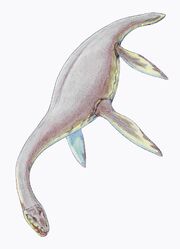| ||||||||||||
The Alvin sea serpent was a sea serpent reported during a deep sea dive off the Bahamas by the submersible Alvin↗ in 1965. According to one of the alleged eyewitnesses, submersible pilot Marvin McCamis, the animal was a reptilian longneck. It has subsequently been described as a possible living plesiosaur, and is sometimes referred to as the Alvin plesiosaur.[1][2]
Background[]
Alleged eyewitnesses Marvin McCamis (1923 – 2004) and Bill Rainnie (1924 – 1985) were engineers who designed and originally piloted Alvin, a prolific deep sea submersible which first went to sea in 1965, in the Bahamas. The sea serpent was allegedly seen by both men during one of these early test dives in the Tongue of the Ocean↗, a very deep stretch of water separating the islands of Andros and New Providence.[3]
Sighting[]
Early reports of the Alvin sea serpent were highly laconic: McCamis was originally quoted as saying "[t]hen I seen this monster or somethin'. I turned around sharply and it's gone. Kind of shook me up. This was a living creature ... I seen at least forty or fifty foot of it."[4][5] McCamis later gave a detailed description of this monster to the Fortean researcher Charles Berlitz, who referred to it in several of his books, always giving the year of the sighting as 1969. Berlitz published McCamis' first-hand account in his book Without a Trace (1977).[3]
| “ | We were down about 5000 feet and then I went down into a crevasse about 300 feet deeper under a slight outcrop. We went deeper because the cable we were following spanned the crevasse. It was right there that I spotted it. The first thing I noticed was the movement. I thought we were moving along the cable and checked for drift but found that the sub was stationary and that it was the object that was moving. It then occurred to me that perhaps it was a utility pole, especially because of its thick shape. I swung the sub in an arc to get a better view along the cable or pole or whatever it was, when I was astonished to see a thick body with flippers, a long neck, a snakelike head with two eyes looking right at us. It looked like a big lizard with flippers - it had two sets of them. Then it swam upwards with its back turned before we could get the cameras angled. They were set to photograph 15 to 25 feet in front of the submarine and the thing had already swum out of the camera angle but was still around. I didn't like the way things were happening, so I came up. I couldn't believe what I was seeing but I didn't want to hang around.
|
” |
McCamis recorded the sighting in the submersible's "wet log," but was later told that the passage had been removed from the final version, and, with no proof of what he saw, he became hesitant to talk about his sighting. One of Berlitz's colleagues, J. Manson Valentine, an entomologist and artist interested in "esoteric archaeology," drew a plesiosaur for McCamis, who identified it as "exactly what [he] saw."[3]
In 1999, cryptozoologist Scott Mardis contacted McCamis, who confirmed the sighting, but claimed that Berlitz got the date wrong; according to him, the observation occurred around July 1965, not 1969, a year in which Alvin was out of commission.[2][1] J. Richard Greenwell of the International Society of Cryptozoology also carried out an interview with McCamis, but the society ceased publishing before the interview could be covered in its newsletter.[6]
Examination[]

The Alvin sea serpent was one of the most explicitly plesiosaurian longnecks ever reported (CC BY-SA 1.0).
The possible identity of the long-necked sea serpent has long been a subject of debate, with most cryptozoologists identifying it as a giraffe-necked pinniped, and a minority favouring the older relict plesiosaur theory.[7][8] Karl Shuker describes the Alvin sighting as "very valuable" due to the credentials of the alleged eyewitnesses, and because the entire animal was seen underwater, as opposted to most longneck sightings, which generally feature only a head and neck periscoping above the surface of the sea. Shuker, who has argued in favour of a plesiosaurian identity for longnecks, describes the appearance of the Alvin sea serpent as "undeniably very reminiscent of a plesiosaur," and regards the sighting as "one of the most compelling [reports] in favour of the reality of a marine cryptid potentially allied to [the plesiosaurs]."[1]
Notes and references[]
- ↑ 1.0 1.1 1.2 Shuker, Karl P. N. (2016) Still In Search Of Prehistoric Survivors: The Creatures That Time Forgot?, Coachwhip Publications, ISBN 978-1616463908
- ↑ 2.0 2.1 Mardis, Scott (2019) Night of the Living Dead Plesiosaurs, ASIN B07NTVDM44
- ↑ 3.0 3.1 3.2 Berlitz, Charles (1977) Without a Trace
- ↑ Bille, Matthew A. (2006) Shadows of Existence: Discoveries and Speculations in Zoology, Hancock House, ISBN 9780888396129
- ↑ Kaharl, Victoria A. (1990) Water Baby: The Story of Alvin
- ↑ Mardis, Scott (2012) "Marvin MccCamis' Sea Monster Encounter, Alvin Submersible" – Online
- ↑ Heuvelmans, Bernard (1968) In the Wake of the Sea-Serpents, Hart-Davis, ISBN 9780246643124
- ↑ Shuker, Karl P. N. "A Supplement to Dr Bernard Heuvelmans' Checklist of Cryptozoological Animals," Fortean Studies, Vol. 5 (1998)

